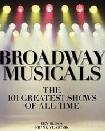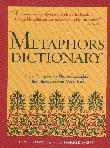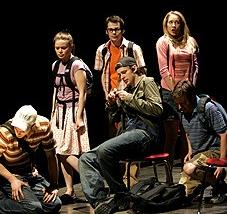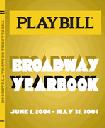SEARCH
REVIEWS
FEATURES
NEWS
Etcetera and
Short Term Listings
LISTINGS
Broadway
Off-Broadway
NYC Restaurants
BOOKS and CDs
OTHER PLACES
Berkshires
London
California
DC
Philadelphia
Elsewhere
QUOTES
On TKTS
PLAYWRIGHTS' ALBUMS
LETTERS TO EDITOR
FILM
LINKS
MISCELLANEOUS
Free Updates
Masthead
Writing for Us SEARCH
A CurtainUp Review
columbinus just the facts
| Columbinus Comes to the New York Theatre Workshop
By Elyse Sommer
You know, someday you'll remember high school as the sick feeling you got every day around noon trying to find a place to eat lunch and I'll remember it as the best years of my life. . . --- Prep during a scene that will be familiar to anyone who's ever been witness to or victim of high school bullying.
With PJ Paparelli, who conceived this play -- or what he prefers to call a "theatrical discussion" -- once again directing, this remains a pungent dramatic examination of a horrendous American tragedy and the cultural climate that spawned it. As in DC, Tony Cisek, Dan Covey, Martin Desjarding and JJ Kaczynski support this intensely dramatic examination of this horrendous American tragedy with outstanding design work A new costume designer, Miranda Hoffman, fits right in with the excellent crafts team The setup of a day at a typical high school whose students are named according to their traits creates a scary and disturbing picture of the social pressures and influences that exacerbate traditionally fragile adolescent self images and let alienated youths like the Loner and Freak fall through the safety net of ineffective counselors and parents and become genuinely evil psychopaths. For all that you expect the end, when it comes it stuns you. Rich See accurately and trenchantly commented on plot and staging, so just jump to his review below. I would add that Columbinus and The History Boys, the best play to hit the Great White Way this season, have something in common besides their school backgrounds. The Broadway hit is the highly literate work of a seasoned pro. It's not just well staged and acted, but superbly so. Yet, despite being entertaining above all, it touches on an important educational and cultural issue: How focusing on passing tests to get into good schools devalues the kind of learning that sustains one through all the pressures and disappointments of life in a high pressure world. Columbinus, on the other hand, was written as an issue drama more than an entertainment. While it IS theatrical and well staged, it's a tough to take, grim story leavened by humor only occasionally. With the incessant talk about the theater as a terminal invalid, my comparison is intended as a ray of optimism. After all, isn't it wonderful to have two such powerful theatrical experiences on the boards! New York Theatre Workshop Production Notes columbinus just the facts written by Stephen Karam and PJ Paparelli Conceived and directed by PJ Paparelli. Cast: Anna Camp, Joaquín Pérez-Campbell, James Flanagan, Carmen M. Herlihy, Nicole Lowrance, *Karl Miller, Will Rogers, Bobby Steggert Set Design: Tony Cisek Damaturgy by Patricia Hersch Costume Design: Miranda Hoffman Lighting Design: Dan Covey Sound Design: Martin Desjardins Projection Design: JJ Kaczynski Fight Direction: Scott Barrow United States Theatre Project at NYTheatre Workshop, 79 East 4th Street (2nd Avenue/ and Bowery) 212/239/6200 Tuesday @ 7pm, Wednesday - Friday @ 8pm, Saturday @ 3pm & 8pm, Sunday @ 2pm & 7pm. From 5/05/06 to 6/11/06; opening 5/ 22/06. Running Time: 2 hours and 15 minutes, including one 15 minute intermission. Tickets, $55 Reviewed by Elyse Sommer based on May 22, 2006 performance |
--The original Roundhouse production review by Rich See
Round House Theatre has premiered a stark new work that compellingly captures the turmoil inherent in today's teenagers. Intensely powerful, the audience simply sat and stared at the stage when the performance ended. No one moving, everyone looking at the names of the dead Columbine High School students scrawled on the stage's chalkboard. It was quite amazing actually.
Written by Stephen Karam, Sean McNall, and PJ Paparelli, Columbinus examines the Columbine school shooting and brings new meaning to the catch phrase "No child left behind." Set, at first, in a fictional high school in American suburbia, the action moves to Littleton, Colorado in the days leading up to and including the shootings on April 20, 1999. The writers have taken a selection of high school archetypes -- the jock, popular girl, Born Again Christian, the smart nerd, the Big Man on Campus, the druggie, the goth and the emotionally unstable social misfit. As each defines and maintains their territory, you see that the same fears and inner turmoil fuel each child, while simply manifesting in different behaviors. Even more interesting is that if you extrapolate these inner fear-based motivators, you see that the majority of adults are simply reliving their high school years -- day in and day out. The acorn doesn't fall far from the tree and the children are not much different than the parents; they simply have less to lose (in their own eyes) by acting out upon their despair.
Having conducted interviews with teenagers across the country and then taken survivor accounts and police transcripts, the writers have created a haunting piece of theatre. Co-writer, conceiver and director PJ Paparelli has pulled the entire package together into an energy-infused drama that is less angst ridden and more soul searching in its approach. Everyone is seen as a product of their environment. The jock, who victimizes the nerd earlier in the play, later becomes a victim himself to the deranged peer with a semi-automatic pistol. What's most striking is the anger and rage within the students. It's not just Eric Harris and Dylan Klebold, the two gunmen of Columbine; all the students seem to be boiling under the surface, seemingly fed on a steady diet of confusion and ego.
Set designer Tony Cisek has created a high school multi-purpose room set. There are basketball court markings on the floor, a blackboard hangs as a backdrop, school chairs and cafeteria tables line the perimeter while backpacks and piles of clothes are neatly stacked about. The stage metamorphoses into classroom, gymnasium, cafeteria, library, bedroom, and pizza parlor with just a few movements.
Dan Covey's lighting design is an interesting use of side spot lights that flows well with JJ Kaczynski's projections. The projections assist the movement of the story from scene to scene and include video segments and photos. Martin Desjardins' soundscape utilizes popular music to bring out the isolation of the teenagers.
Costume designer Denise Umland has pretty much given each character a distinctive look by their clothes. Sort of a uniform for the archetype. The cheerleader wears miniskirts, the jock sweat pants, the popular guy has polo shirts, while the counter-culture girl has neon red highlights in her hair. More interesting is the point, at the outset of the play, when each student chooses their accessory of choice. Hanging display shelves, holding an item that signifies a particular child, fall from above -- glasses for the intellectual, necklace for the pretty girl, cross for the Christian, baseball cap for the jock, etc. As each chooses their particular item it is almost a symbolic moment of identity choice. Energetically it's quite fascinating, especially when you see that the confused characters of Eric Harris and Dylan Klebold have no identity anchor.
The ensemble is excellent. Karl Miller provides a raw, hate-filled presence as Eric. His venom filled diatribes are exhausting to watch. Meanwhile, Will Rogers is a much more pliable and sympathetic Dylan, seemingly a follower to Harris' more powerful presence. The damaged psyches of the two are disturbing as they embrace Hitler and the idea of the uebermensch as a salve for their inner demons. Interestingly, they seemingly have no real context about their actions. They are simultaneously planning their future lives while also planning their suicides.
Anne Bowles as the popular girl presents an interesting mix of self-absorbed confidence and little girl lost, which contrasts directly with Jeanne Dillon's Born Again Christian. Ms. Dillon is unassumingly funny as she tries to be a role model to underclassmen, yet navigate her way through high school while maintaining her religious beliefs. James Flanagan is an endearing intellectual nerd, confused by his ease in academics and his utter hopelessness at athletics.
Daniel Frith is the good looking, popular man on campus who secretly hates himself because he is gay. Buying into the idea that high school must be the best years of his life, you feel sorry for him. We all know people who capped off at high school and seem to be reliving their "golden years" over and over in their own minds, never moving forward in their lives.
Ekatrina Oleksa's counter-culture girl is quite touching as she says "I'm uncomfortable with me..." Attracted to Will Rogers' outsider, she vocalizes the reason as because "You are possible, obtainable..." It's a wonderful mirror to how our self-images sabotage us into "settling" for something. Gene Gillette makes a realistic jock who is almost comical in his sense of duty. Rough and tough, he ascribes to the idea of there being one "right way" to be, look, think, and behave; yet underneath all the machismo he is very much an adolescent.
Columbinus is not all pain and tragedy. There are some very poetic and humorous moments within its script. Eric Harris' bomb making speech is especially funny, as is the point where Will Rogers tries to ask out Miss Oleksa. However, from a psychological perspective it's the individual monologues where you see the pressure these kids are placing upon themselves, the limiting beliefs they are buying into, the short-sighted views they have of the world and their lives, and the underlying desperation with which they live that is so fascinating and disturbing. The shootings are incidental to the greater cultural aspects the students represent. Sadly the adults around them seem to be fueling and buying into these same belief systems.
This is the first work of the United States Theatre Project, which has dedicated itself to examining the events that impact our culture. They have set off on a terrific start with Columbinus (a Latin medical term for "examination" that when literally translated means "dove-like"). The ending of the play is superb and sobering, as the moments before the shooting each youth is grappling with their own inner conflicts and struggles in a slow motion montage. The fact the actors do not emerge for a final bow is a tribute to those students who died in Littleton, Colorado and who ultimately receive the final applause. This is a must see.
|
Columbinus by Stephen Karam, Sean McNall, and PJ Paparelli Directed by PJ Paparelli with Anne Bowles, Jeanne Dillon, James Flanagan, Daniel Frith, Gene Gillette, Karl Miller, Ekatrina Oleksa, Will Rogers Set Design: Tony Cisek Costume Design: Denise Umland Lighting Design: Dan Covey Sound Design: Martin Desjardins Projection Design: JJ Kaczynski Running Time: 2 hours and 30 minutes with 1 intermission A production of Round House Theatre and the United States Theatre Project Round House Theatre Silver Spring, 8641 Colesville Road, Silver Spring, MD, Telephone: 240-644-1100 WED @7.30; THU - SAT @8, SUN @3; $10 - $35 Opening 03/03/05, closing 04/03/05 Reviewed by Rich See based on 03/07/05 performance |
The Internet Theatre Bookshop "Virtually Every Play in the World" --even out of print plays

Easy-on-the budget super gift for yourself and your musical loving friends. Tons of gorgeous pictures.
Leonard Maltin's 2005 Movie Guide

6, 500 Comparative Phrases including 800 Shakespearean Metaphors by our editor.
Click image to buy.
Go here for details and larger image.









